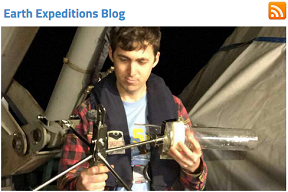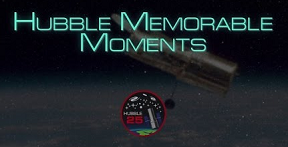Odyssey of the Mind is the premier creative problem-solving competition for students. NASA scientists and engineers are also in the business of creating innovative approaches to some of the most challenging problems we face – from understanding our complex Earth system to exploring our solar system and beyond.
This collection features NASA people and resources, pointing to how scientists and engineers jump-start the creativity and problem-solving process.
This collection was created based upon work supported by NASA under award No. NNX16AE28A. Any opinions, findings, and conclusions or recommendations expressed in this material do not necessarily reflect the views of the National Aeronautics and Space Administration.
| NASA Resource Title | Description |
|---|---|
Earth Expeditions |
NASA’s view from space shows our planet is changing, but to really understand the nitty-gritty of these changes and what they mean for our future, scientists need a closer look. NASA takes you on a world tour as we kick off new field research campaigns to study regions of critical change from land, sea and air. Most interesting for students would be the videos and NASA blog posts. Each bring the latest first-hand stories directly from the field so you can follow @NASAEarth and @NASAairborne and the hashtag #EarthExpedition on Twitter for the very latest details. http://www.nasa.gov/earthexpeditions https://blogs.nasa.gov/earthexpeditions/ |
Earth Observatory
|
The Earth Observatory shares images, stories, and discoveries about the environment, Earth systems, and climate that emerge from NASA research, including its satellite missions, research, and models. Most interesting for students would be the notes-from-the-field; first hand accounts from NASA researchers. Example: A Tale of Fire and Water: A NASA Scientist’s Quest to Understand the Rain in Africa http://go.nasa.gov/2dNv0AA |
Global Climate Change |
Learn more about the science problems NASA scientists are working on related to changing climate. NASA Global Climate Change Blog Most interesting for students would be watching the Earth Minute whiteboard series. It introduces Earth Sciences to the curious. http://climate.nasa.gov/climate_resource_center/earthminute |
Hubble Memorable Moments
|
In celebration of the 25 years since the Hubble Space Telescope's April 1990 launch, NASA's Goddard Space Flight Center recalled intense moments throughout Hubble's history that were memorable for Goddard's engineers and flight operators. Most interesting for students would be the following: Tinkertoy Solution Shortly after its April 1990 deployment, operators found that its high-gain antenna was mysteriously stuck. Team members recall that intense week and how they ultimately solved the antenna problem. Brute Force The team scrambles to work out an unusual solution to a problem encountered during an instrument repair. Comet Impact In July 1994, the Hubble Space Telescope was poised to use its newly fixed optics to observe one of the most impressive astronomical events of the century - the 21 fragments of Comet Shoemaker-Levy 9 impacting Jupiter. But these observations almost didn't happen. Powering Down In 1999, engineers at NASA's Goddard Space Flight Center discovered that there was a problem with Hubble's Power Control Unit. Hubble team members came up with a plan to replace the unit on Servicing Mission 3B. On March 6, 2002, the day came to put that plan into action. What could go wrong? |
NASA Spinoff
|
Each year, Spinoff highlights NASA technologies that are benefiting life on Earth in the form of commercial products. Nearly 2,000 spinoffs have been featured since the publication began in 1976 — there’s more space in your life than you think! |
Get Involved: NASA Solve
|
NASA Solve is an invitation to members of the public to contribute their time and expertise to advancing research, solving problems, and potentially winning prizes as a result of their work. Specific projects listed on this site that engage people in problem solving include crowdsourced challenges and prize competitions, citizen science projects, and competitions aimed at advancing student education, and many more activities. Students will find this interesting because NASA Solve is a gateway for everyone to engage in the nation’s aerospace program through challenges, prize competitions, and crowdsourcing. |
Women@NASA
|
This website includes a collection of 64 videos and essays from women across the agency who contribute to NASA’s mission in many different ways. We hope to give you a glimpse of the talent we have at the agency today. Coaches and students would find this interesting because their stories illuminate the vibrant community of dedicated women employees who play a vital role at the agency. You’ll hear stories of women overcoming almost every obstacle imaginable to pursue their dreams and make a difference in the world. |
| Featured People from NASA Science | Science is interconnected. What starts with a question, leads to new discoveries. Those answers lead to new questions to build on ... we do the seemingly impossible every day. Coaches would find this interesting because NASA’s Science Mission Directorate is an organization where discoveries in one scientific area also have a direct connection to other areas of research. Check out the People tab. |
| NASA Education EXPRESS | The NASA Education EXPRESS message features updates from NASA and STEM associates about workshops, internships, and fellowships; applications for grants or collaborations; promotions for student and educator opportunities; online professional development; and other announcements. Of interest for students are the student projects and programs found here. |
| Science WOW! | The "Science WOW!" message features NASA’s latest science education offerings delivered “Weekly on Wednesdays.” Each week's message kicks off with a science question-and-answer and a featured science education tool. Of interest for students and coaches are the latest science education opportunities offered by NASA, including professional development webinars, student contests, workshops, lectures and more! |
| Visualizing Earth Systems | Earth Science Week (ESW) is an initiative of the American Geosciences Institute (AGI). NASA is a partner in ESW, and In celebration of the 2015 ESW, created this series of blog posts by NASA scientists, engineers and educators talking about how they “Visualize Earth Systems.” Of interest to students are the first-hand stories and interview-like blogs with NASA visualizers and scientists. |
|
openNASA Non NASA website cultivating creative thinking and problem solving. |
“Our future depends on innovators who can bring together diverse talents and perspectives to imagine and implement new solutions and ventures.” Nick Skytland works at NASA JSC and wrote about the International Space Apps Challenge. These are activities that value creativity and require “outside-the-box” thinking. The idea of a Salon incentives students to apply the use of a creative process in order to develop innovation solutions to tough challenges. The approach is much more engaging than a lecture about a topic and challenges the students to develop creative solutions to real problems facing real organizations. Most interesting for students would be: The Space Apps Challenge - a NASA incubator innovation program. It’s not just for coders. Beginners, students, experts, engineers, makers, artists, storytellers -- Space Apps is for you! We welcome all passionate problem solvers to join our community of innovators. Citizens like you have already created thousands of open-source solutions together through code, data visualizations, hardware and design. How will you make your global impact? https://2016.spaceappschallenge.org/ |
| NASA iSeries: Understanding your Creative Genius | An in-house video created to “Understand your Creative Genius” |
| TED Talks by NASA | TED is a global community, welcoming people from every discipline and culture who seek a deeper understanding of the world. We believe passionately in the power of ideas to change attitudes, lives and, ultimately, the world. On TED.com,is a clearinghouse of free knowledge from the world's most inspired thinkers — and a community of curious souls to engage with ideas and each other, both online and at TED and TEDx events around the world, all year long. Most interesting for students would be: Fred Jansen on How to land on a comet. As manager of the Rosetta mission, Fred Jansen was responsible for the successful 2014 landing of a probe on the comet known as 67P/Churyumov-Gerasimenko. In this fascinating and funny talk, Jansen reveals some of the intricate calculations that went into landing the Philae probe on a comet 500 million kilometers from Earth — and shares some incredible photographs taken along the way. Jon Nguyen on Tour the solar system from home. Want to navigate the solar system without having to buy a spacecraft? Jon Nguyen demos NASA JPL's "Eyes on the Solar System" — free-to-use software for exploring the planets, moons, asteroids, and spacecraft that rotate around our sun in real-time. Randall Munroe at TED2014 Using serious math to answer weird questions. Cartoonist (and former NASA roboticist) illustrates the questions that keep you (or at least him) up at night. Whether that’s “What would happen if you tried to hit a baseball pitched at 90% the speed of light?” or “How much of the Earth’s currently-existing water has ever been turned into a soft drink at some point in its history?” he’s got you covered. James Green at TED2015 on 3 Moons and a planet that could have alien life. Is there life beyond Earth? Join NASA's director of planetary science James Green for a journey to the places in our solar system that are most likely to harbor alien life. |
NASA Wavelength |
NASA Wavelength is a pathway into a digital collection of Earth and space science resources for educators of all levels – from elementary to college, to out-of-school programs. Use Wavelength to quickly and easily locate resources, connect them to other websites using atom feeds, and even share the resources you discover with others through social media and email. Coaches and educators would find this most interesting: Resources from Wavelength using problem solving Examples of what you’ll find in Wavelength: Mars Rover Celebration: The individual lessons in this 6-week curriculum are in NASA Wavelength; the link below takes you to the complete curriculum, which takes teachers and students through an abbreviated simulation of the actual process that NASA scientists and engineers follow to create a mission to Mars. Each week has its own theme. The first weeks establish and create background knowledge for students to successfully carry out the research they will need to design their own mission, create their Mars Rover, select and appropriate landing site, build a prototype, and to write a presentation/skit to perform at the culminating event. Two sets of lessons are provided: for grades 3-5 and grades 6-8. Measuring Precipitation. Students will design, build and then test a rain gauge to measure precipitation. By sharing their results, they will recognize the need for standardization and precision in scientific tools. All background information, student worksheets and images/photographs/data are included in these downloadable sections: Teacher’s Guide, Student Capture Sheet and PowerPoint Presentation. This activity uses the 5E instructional model and is part of Survivor Earth. Engineer a satellite. In this activity, learners select the scientific instruments for their satellite, calculate the power requirements for all the subsystems, and construct a scale model of their very own Earth observing satellite using building blocks and/or Legos. Includes instructions and worksheets. Building for Hurricanes: Engineering Design Challenge. This activity is a short engineering design challenge to be completed by individual students or small teams. A real-world problem is presented, designing buildings for hurricane-prone areas, but in a simulated way that works in a classroom, after school club, or informal education setting. Students are given simple materials and design requirements, and must plan and build a tower as tall as possible that will hold up a tennis ball while resisting the force of wind from a fan. After the towers are built, the group comes together to test them. If there is time after testing, which can be observational or framed as a contest between teams, students can redesign their towers to improve their performance, or simply discuss what worked well and what didn’t in their designs. |
